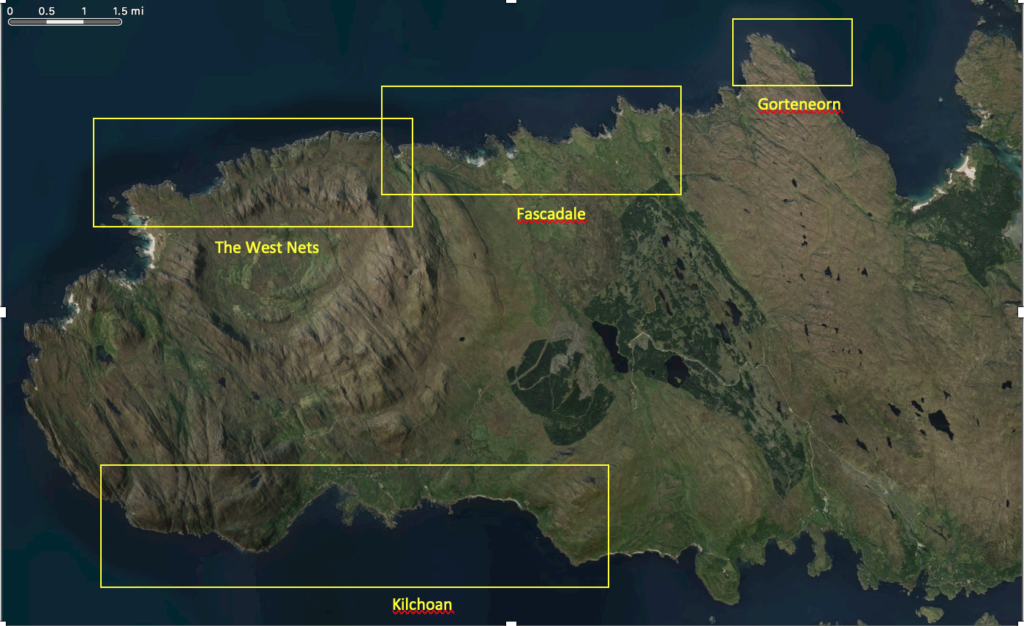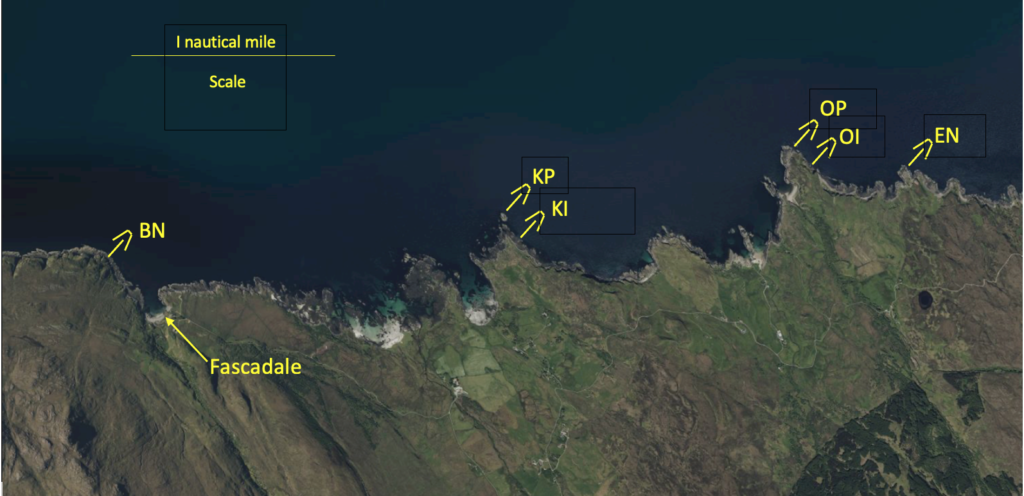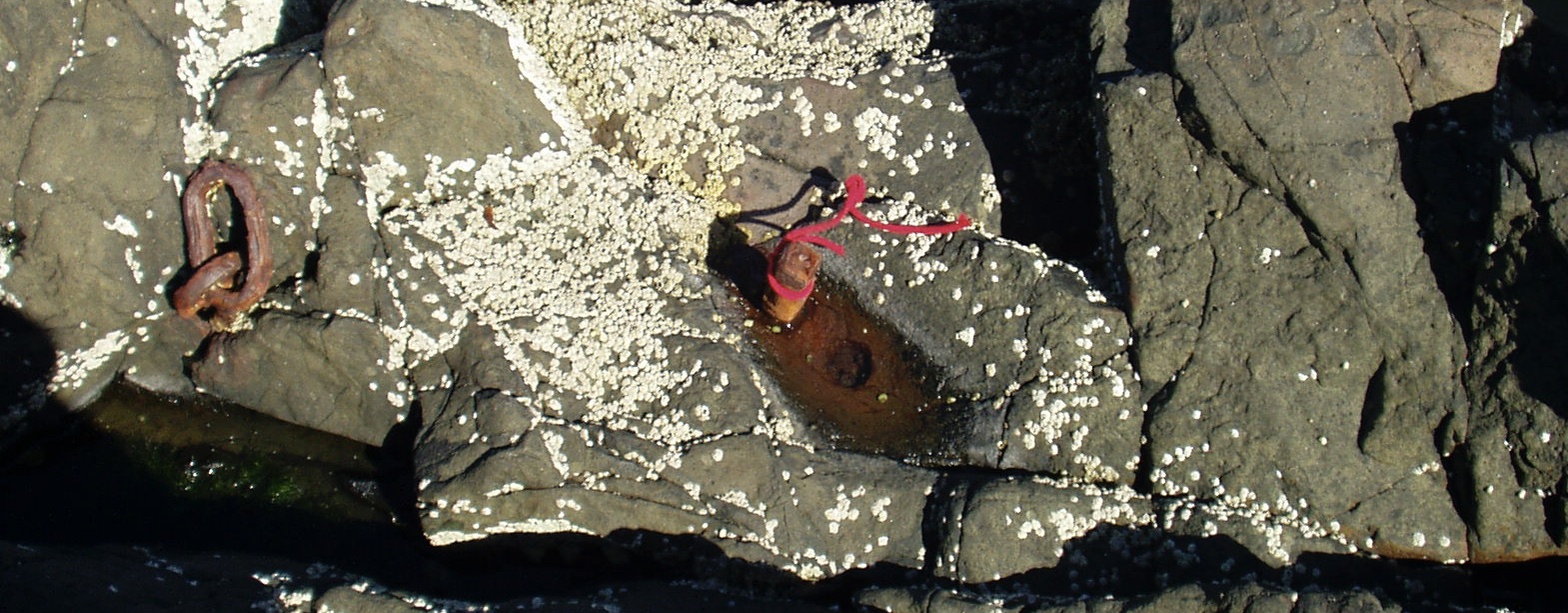Positions and pins
The illustrations below show the positions of the nets at the different fishing stations
It is not known why the nets were in these specific places. In the 1970s if the question was asked then the answer usually was “this is where they have always been and this is where they catch the most fish”
There are a number of similarities between the net positions. They are always positioned on the down tide side of a small promontory or headland. On the north coast of the peninsula they lie from South West to North East, on the south coast from North West to South East.
The nets were also set in tidal eddies, places where, on the north coast the curve of the leader indicated that the tide ebbed, or flowed to the west for nine hours and only showed a flood, or eastwards flow for 3 hours. This was reversed on the south coast of Ardnamurchan. On these coasts you would expect a six hour flood and a six hour ebb.
So why were the nets set in these eddies?
It might be that the tide flowed with less power in the eddies making the nets easier to keep in place or that there was a bit of shelter from the sea conditions making the nets easier to fish
There may also be an explanation in the behaviour of the fish themselves. Perhaps they preferred to swim with the tide: maybe they took short breaks from their marathon journeys by resting in a eddy
Unfortunately modern science offers little information on this. When asked about the behaviour of fish close to the coast Dr Richard Shelton, author of the authoritative “To Sea and Back: The Heroic Life of the Atlantic Salmon” says “Very little is known about the coastal swimming behaviour of returning salmon but its likely that they swim uptide as part of their homing behaviour.”
Or it just might be that our forefathers through years of observation and perhaps trial and error really did know where the most fish were along the coast and thus the best places to position nets

The Fascadale nets

There were up to six bagnets fished from Fascadale in the 1970s and 1980s
The nets were BN, the Bay net, often referred to as “The Bank” as it was the most reliable net, the one you could bank on. This was always the first net in and the last net out each season
KP, Kilmory Point, although on maps and charts the point is actually shown as “Ardtoe Island” In 1975 this net produced the biggest single catch, 47 fish in one fishing
KI, Kilmory Inside, this was usually a calm and peaceful place. an easy net to fish but not a star performer.
OP, Ockle Point, this was the most difficult, the most exposed to the wind and the waves, the net with the strongest tide running through it. Two of the shore pins to hold this net in place were on a rocky islet only accessible at the lowest of tides and sometimes awash as the shore chains were being shackled on. Never a fun place to be
OI, Ockle Inside. It was usually a relief to get to Ockle Inside after being at Ockle Point. It was a sheltered spot, under some impressively steep clifflike slopes inhabited by feral white goats in the seventies. An average sort of net for fish
EN, the East Net, this felt and was a really remote place. An easy net to fish, not much tide through it, seldom heavy with jellyfish but a very sporadic net for fish. It had a reputation for taking a higher proportion of bigger fish than the other nets
In 1975 with two in the “Wee” coble only the three nets near Fascadale, the Bay net and the two Kilmory nets were fished. In 1976 and subsequent years with the purchase of the bigger OB 226 “Iolair” all six nets were fished with a crew of four
The Kilchoan nets

J&L, Jib and Lug, the most westerly, the most exposed and the furthest of the Kilchoan nets. This net has not been fished since before the 1970s
RnG, Rhu na Gall, This net was in a very dramatic spot, round the corner and out of sight, it felt and it was very remote. At the foot of big cliffs and exposed to the prevailing south west wind it always felt very exposed. This net was fished in the 1980s
CN, the Croft net, also sometimes known as the Twins: This net was just below the furthest west or last house, known as “the Twins” in Ormsaigbeg. This was one of the last nets fished in Ardnamurchan before the ban. Dochie Cameron worked the net into the 2000s
PN, the Pier Net. This was also one of the last nets fished by Dochie into the 2000s
MP, Mhile Point: also know as the Castle, this net sat off a rocky promentory just below the Mingary Castle which was then a rather romantic ruin. Every year or so the Royal Yacht “Britannia” with an accompanying warship would anchor nearby during the Queen’s summer cruise It was fished in the 1980s
McLn, Maclean’s Nose: this net was in the most imposing location of all the Ardnamurchan nets: at the foot of Ben Hiant, huge cliffs, a real feeling of remoteness It was a tremendous place to be but unfortunately it caught few fish and took a long time to get to and from. It was fished in the 1980s
The Gorteneorn Nets

The West Nets

